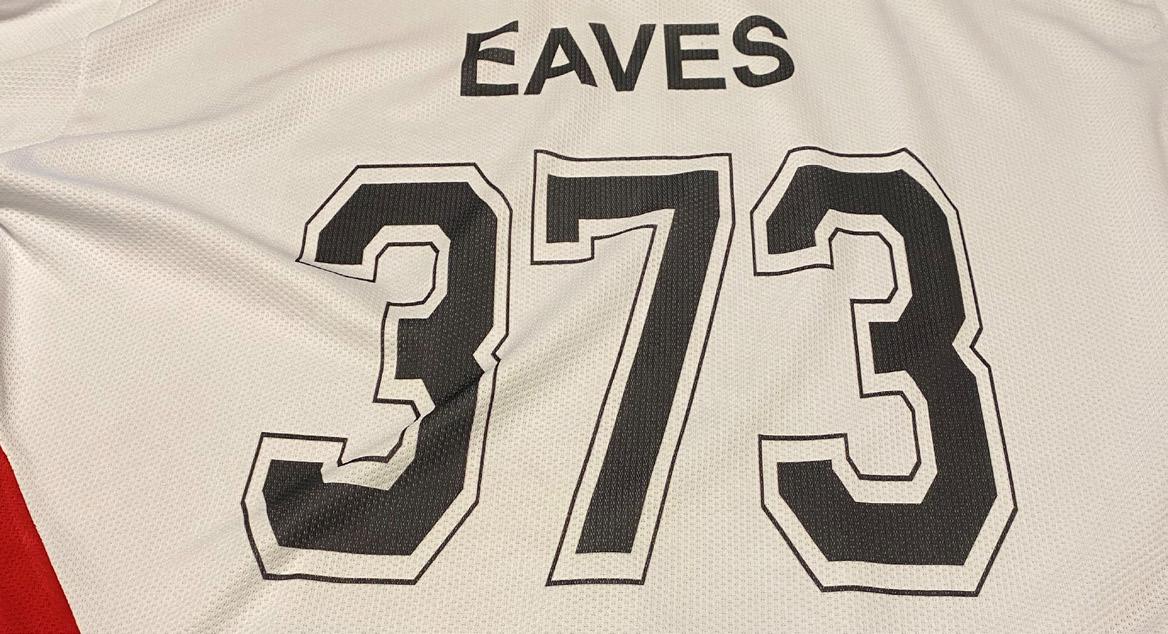
13 minute read
Phi Sigma Kappa Brothers make NASA History
With Elon Musk’s SpaceX, there has been a renewed interest in the nation’s space program. Missions to Mars seemed like science fiction since Neil Armstrong first stepped on the Moon in 1969 and even before that. Now, it seems that may happen within the next five years.
Phi Sig brothers have made their mark on the space program, by way of the military, and eventually NASA. Read about three brothers who have been to space.
Daniel Charles Brandenstein (Wisconsin/River Falls ‘65) is a former naval aviator, test pilot, and NASA astronaut, who flew on four Space Shuttle missions. He also served as Chief of the Astronaut Office from 1987 to 1992 and is the former Executive Vice President and COO of the now defunct United Space Alliance.
After graduating with a bachelor’s degree in mathematics and physics, Brother Brandenstein entered active duty with the U.S. Navy in September of 1965 and was attached to the Naval Air Training Command for flight training. He was designated a naval aviator in May of 1967. From 1968 to 1970, he participated in two combat deployments on board the aircraft carriers USS Constellation and USS Ranger to Southeast Asia, where he flew 192 combat missions. In subsequent assignments, he conducted operational tests of weapons systems and tactics.
Upon graduation from the U.S. Naval Test Pilot School, he conducted tests of electronic warfare systems in various Navy aircraft. Brother Brandenstein carried out a nine-month deployment to the Western Pacific and Indian Ocean on board USS Ranger from March of 1975 until September of 1977. Before reporting to the Johnson Space Center in Houston as an astronaut candidate, he served as a flight instructor.
Selected by NASA in January of 1978, Brother Brandenstein became an astronaut in August of 1979. A veteran of four space flights—Challenger (August 30-September 3, 1983), Discovery (June 17–24, 1985), Columbia (January 9–20, 1990), and Endeavour (May 7–16, 1992)—Brother Brandenstein has logged more than 789 hours in space. He was the pilot on the Challenger flight and commander for the other three missions.
Following his second space flight, he served as the Deputy Director of Flight Crew Operations. Between April of 1987 and September of 1992, he served as Chief of the Astronaut Office. The Challenger flight was notable because it was the first mission with
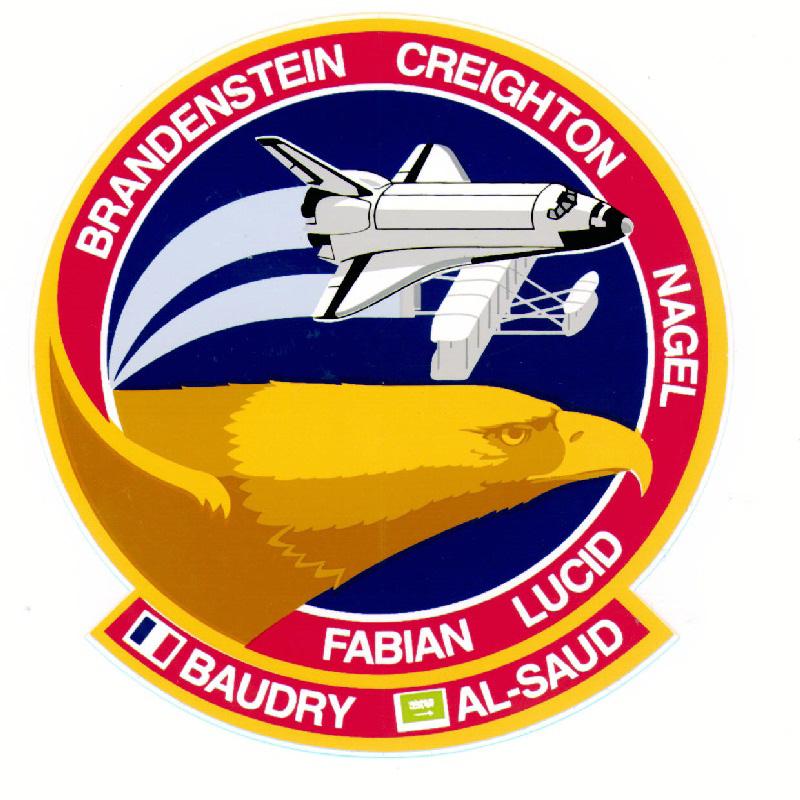
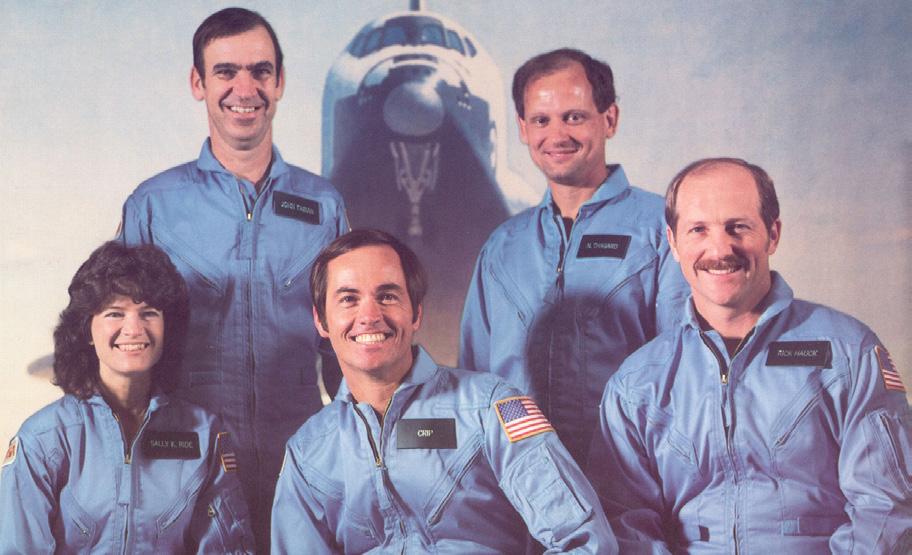
THE CREW OF CHALLENGER IN JUNE OF 1983
a night launch and night landing. The 1992 Endeavour mission was the maiden flight of the new shuttle. During this mission, the crew performed a record four space walks to retrieve, repair and re-deploy the International Telecommunications Satellite.
Brother Brandenstein retired from NASA and the United States Navy in October of 1992. In 1993, he served as the assistant to the Vice President and General Manager of IBM Federal Systems Company for the Space Station Program. From 1994 to 1996, he worked for Loral Space Information Systems, first as Director of Quality Assurance and then as Director of Program Development.
From 1996 to 1999, he served as Executive Vice President and Program Manager for the Kistler Aerospace Corporation, where he was responsible for the design and development of a commercial reusable launch vehicle. He then served as Vice President and Program Manager for the Mission Support Operations Contract at the NASA/Johnson Space Center for Lockheed Martin Mission Services until moving to his position at United Space Alliance in 2007.
In October 2007, he joined United Space Alliance as Executive Vice President and Chief Operating Officer. Before it was dissolved in December of 2019, United Space Alliance was NASA’s primary industry partner in human space operations, including the Space Shuttle and the International Space Station.
Brother Brandenstein was awarded the Defense Superior Service Medal with oak leaf cluster, the Legion of Merit, the Distinguished Flying Cross, the Defense Meritorious Service Medal, 17 Air Medals, the Navy Commendation Medal with oak leaf cluster and Valor device, a Meritorious Unit Commendation, two NASA Distinguished Service Medals, two NASA Outstanding Leadership Medals, four NASA Space Flight Medals, the National Defense Service Medal, the Armed Forces Expeditionary Medal, the Vietnam Service Medal, a Sea Service Deployment Ribbon, the French Legion of Honor, the Medal of King Abdul Aziz (Saudi Arabia), the Vietnam Air Gallantry Cross, the Vietnam Gallantry Cross Unit Citation and the Republic of Vietnam Campaign Medal. He was inducted into the United States Astronaut Hall of Fame in 2003.
John M. Fabian (Washington State ’61) is a former NASA astronaut and Air Force officer who flew two space shuttle missions and worked on the deployment of the shuttle’s robotic arm. He later led the Air Force’s space operations.
Brother Fabian received a bachelor’s degree in mechanical engineering and a master’s degree in aerospace engineering from the U.S. Air Force Institute of Technology in 1964. He also earned his doctorate’s degree in aeronautics and astronautics from the University of Washington in 1974.
Brother Fabian, an Air Force ROTC student, was commissioned upon graduation. After earning his master’s degree, he was assigned as an aeronautics engineer. He then attended flight training and spent five years as co-pilot, aircraft commander, and instructor. He saw action in Southeast Asia, flying 90 combat missions during the Vietnam War. He then spent four years on the faculty at the U.S. Air Force Academy.
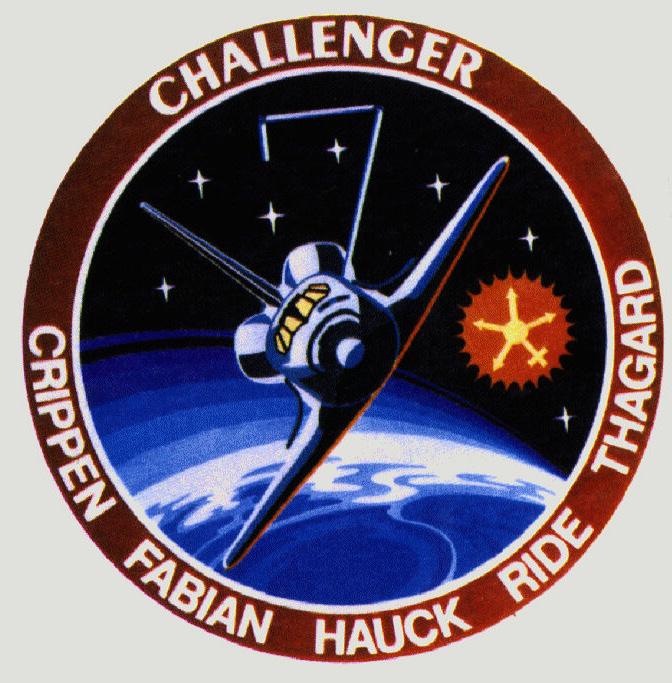
Selected as an astronaut candidate by NASA in January of 1978, he became an astronaut in August of 1979. He is a veteran of two space flights—Challenger (June 18-24, 1983), and Discovery (June 17-24, 1985). He was a mission specialist on both flights. The Challenger flight is memorable because it was on that mission that Sally Ride became the first U.S. woman in space. It was also the first mission with a fiveperson crew. Brother Fabian has logged more than 316 hours in space. He was the first person to deploy and subsequently retrieve a free-flying satellite.
In an amazing coincidence, Brothers Brandenstein and Fabian became fraternity brothers just two months after they flew together on Discovery in June of 1985. The Merger of Phi Sigma Kappa and Phi Sigma Epsilon took place in August of 1985. Brandenstein, a member of Phi Sigma Epsilon and Fabian, a member of Phi Sigma Kappa, were then connected not only by their NASA experience, but fraternally, as well.
On the Discovery mission, the international crew deployed communications satellites for Mexico, the Arab League, and AT&T Telstar.
Brother Fabian left NASA in January of 1986 to become Director of Space, Deputy Chief of Staff, Plans and Operations, of the U.S. Air Force. He retired from the Air Force in June of 1987 and joined Analytic Services, a nonprofit aerospace public service research institute, where he retired as President and CEO in 1998.
Brother Fabian was awarded Air Force Astronaut Wings; NASA Space Flight Medal with one Oak Leaf Cluster; NASA Exceptional Public Service Medal; Federation Aeronautique Internationale - Komarov Diploma; Defense Superior Service Medal with one Oak Leaf Cluster, Legion of Merit, Defense Meritorious Service Medal, Air Force Meritorious Service Medal, French Legion of Honor, Saudi Arabian King Abdul Aziz Medal, Air Medal with 2 Oak Leaf Clusters, and the Air Force Commendation Medal.
He received the Fraternity’s Distinguished Alumnus Award in 1985 and the Medallion of Merit in 1987. He served as a Phi Sigma Kappa Foundation Trustee or Honorary Trustee from 1991 until 2011.
THE CREW OF DISCOVERY IN JUNE OF 1985
IN 1969, APOLLO 12 SPLASHED DOWN IN THE PACIFIC OCEAN. ASTRONAUTS, FROM LEFT, CHARLES CONRAD, RICHARD GORDON, AND ALAN BEAN PEER OUT OF THE WINDOW OF THE MOBILE QUARANTINE FACILITY ABOARD THE RECOVERY SHIP, USS HORNET.
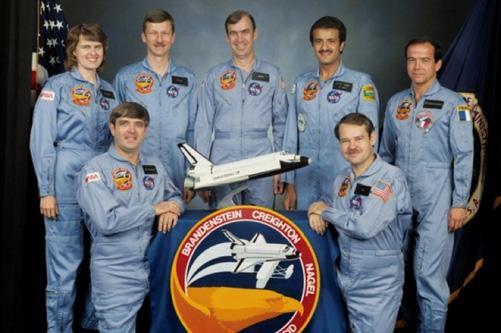
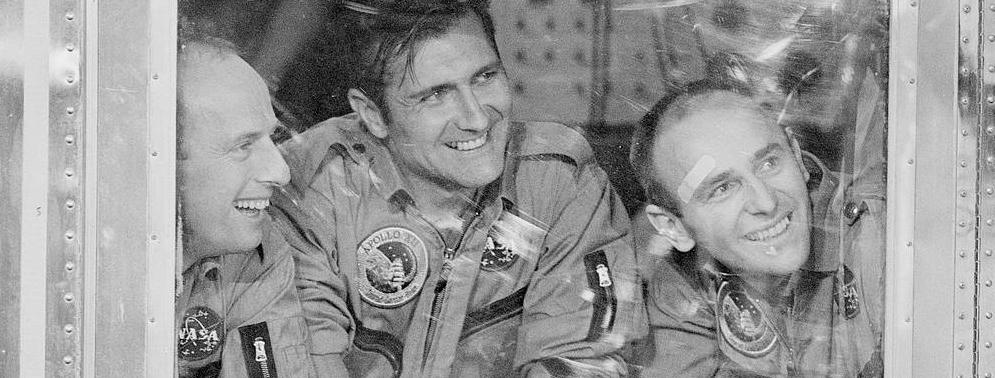
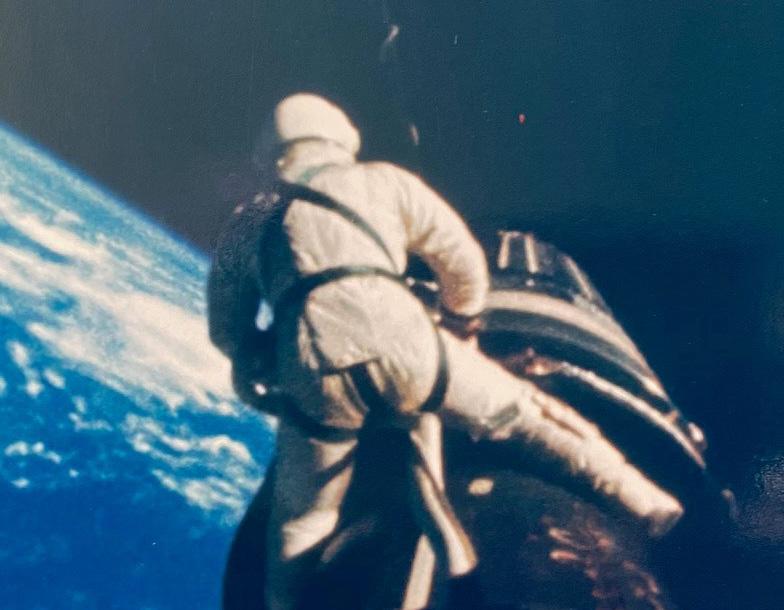
Richard F. Gordon (Washington ’51) was an American naval officer and aviator, test pilot, and NASA astronaut. He was the command module pilot of the Apollo 12 mission in 1969.
Brother Gordon received a bachelor’s degree in chemistry and joined the U.S. Navy after graduating from college. He received his wings as a naval aviator in 1953. He served as a flight test pilot until 1960 and served as a flight instructor, a flight safety officer, and ground training officer.
He was one of the third group of astronauts, introduced by NASA in October of 1963. Brother Gordon served as backup pilot for the Gemini 8 flight. He also served as backup pilot for Apollo 9 and Apollo 15. In September of 1966, he made his first space flight, as pilot of Gemini 11. While on the flight, he performed two spacewalks. In November of 1969, he flew as command module pilot of Apollo 12, the second manned mission to land on the Moon.
Brother Gordon logged nearly 316 hours in space. He became Chief of Advanced Programs in 1971 and worked on the design of the space shuttle. He retired from NASA and the Navy in January of 1972.
After leaving NASA, he served as Executive Vice President of the New Orleans Saints from 1972 until 1976. He also worked for several companies involved in the oil and gas industry. In the summer of 1984, Brother Gordon was a technical adviser for and played the part of “Capcom” in the CBS miniseries “Space,” by James A. Michener. He served as Chairman and co-Chairman of the Louisiana Heart Fund, Chairman of the March of Dimes, Honorary Chairman for Muscular Dystrophy, and on the boards of directors or the Boy Scouts of America, and Boys’ Club of Greater New Orleans.
His numerous awards include Navy Astronaut Wings, NASA Distinguished Service Medal, NASA Exceptional Service Medal, the 1961 Bendix Trophy, two Navy Distinguished Flying Crosses, and the Navy Distinguished Service Medal. Brother Gordon was inducted into the International Space Hall of Fame in 1982. He was inducted into the United States Astronaut Hall of Fame in 1993.
He was the recipient of the Fraternity’s Medallion of Merit in 1964.
Brother Gordon joined the Chapter Eternal on November 6, 2017 and is buried in Arlington National Cemetery.
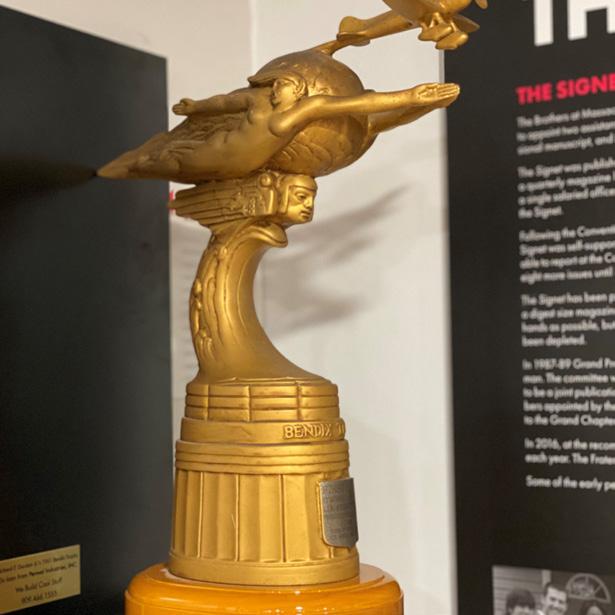
DICK GORDON’S BENDIX TROPHY IS ON DISPLAY IN THE SHONK ARCHIVE AND EDUCATIONAL CENTER. WE HOPE YOU’LL GET A CHANCE TO VISIT WHEN WE ARE ABLE TO HOST AN OFFICIAL OPENING.

BROTHER DICK GORDON WINS FAMOUS BENDIX TROPHY
Brother Dick Gordon flew from coast to coast in an F4H-1 on May 24, 1961 in 2 hours and 47 minutes, to eclipse a record that had stood since 1957. In accomplishing this feat, Brother Dick Gordon shared the Bendix Trophy with his radio-intercept officer Bobbie R. Young.
Brother Gordon flew from Ontario International Airport, east of Los Angeles, to Floyd Bennett Field, New York and set a new speed record of 869.74 miles per hour, according to Wikipedia.
The duo’s average speed was the highest ever in the trophy races, that began in 1931 with James H. Doolittle setting an average mark of 223 miles per hour between Los Angeles and Cleveland. Another notable figure in the history of the Bendix Trophy is Amelia Earhart, who finished in fifth place in 1935. She was the first woman to enter the race.
The Bendix Trophy was sponsored by industrialist Vincent Bendix, founder of Bendix Corporation. The race began in 1931 as part of the National Air Races. The races were organized to test pilot training, equipment, and technical skills of American aviation. The last Bendix Trophy Race was flown in 1962.

Brother Gordon’s Bendix Trophy is now on display in the Shonk Archive and Educational Center at the International Headquarters. The trophy is on loan from Chris Pennington (Southern Cal AI). Read about Brother Gordon in the preceding pages of this issue.
Sean Eaves (Midwestern State ’93) has been a Trustee of the Phi Sigma Kappa Foundation for nearly three years. He currently serves as Secretary of the Foundation and is also a member of the Foundation’s Nominating Committee.
Brother Eaves explains that he actually became a Phi Sig by accident. He wasn’t going through fraternity recruitment. The brothers from Sigma Tetarton were actually recruiting his roommate. Coincidentally, his roommate’s name was also Sean. He said he “just kept hanging out and I guess they liked me.”
He stays involved because he says “This PSK vehicle changed my life. The seminal moment when Brother Jason Christie (Midwestern State ’93) (deceased) asked me as a Christmas present to come back one more semester when I was planning to not come back in the spring of 1991 changed my life forever. I would not have been married to the same person. I would not have the friends, job, or life, literally. I want this to be around for any brother so that PSK can have the same influence on his life.” Brother Eaves initiated on January 11, 1991.
His favorite Phi Sig memory comes from a time as an undergraduate when he wasn’t an officer or even on any committees. The chapter was at spring formal and during dinner, the topic of Active of the Year came up and he wondered who it could be. He didn’t even remember voting on the issue. When it was announced that Brother Eaves was to receive the honor, he says, “It was truly one of the only times I can remember being genuinely shocked.” Brother Eaves is in his eighth year employed in health insurance sales for US Health Advisors and lives in Dallas, Texas. He is married to his husband, Jason, who is employed as a school teacher. They will soon celebrate 11 years on their next anniversary.
Sean loves to cook and is an avid sports fan. He will watch or play any sport. He is currently trying to get better at golf and thinks that will happen when he retires!
Phi Sigma Kappa has impacted his life in a myriad of ways. He was Recruitment Chair for two years as an undergraduate. As a result, he is not afraid to walk up to anyone and make friends. He also thinks his sales profession is a direct correlation to his role as Recruitment Chair. He explains that the brothers of Sigma Tetarton are very accomplished and hard working. It was true as undergraduates and remains the same today. He explains that it sets a bar where individuals can’t be mediocre. He strives to be the best because of that bar. Phi Sigma Kappa has also given him the ability to relate and connect with many different people. He says he will be forever grateful for that.
When asked what his brothers mean to him, Brother Eaves said, “I hate to say the cliché, everything. But everything is so accurate. To this day, my pledge (associate) brothers and I are so close. We see and talk as regularly as time will permit. I am so very close with a lot of my brothers from many different generations of Sigma Tetarton. I feel so incredibly lucky to have met some of the best human beings and men. And the fact that we can call on each other in the most important times and be there for each other. I know that goes on lots of places, but I can tell you it is rarefied air with these men I get to call my brothers. And since I have been on the Foundation how much I have bonded with these men I don’t have as much history with. When my father died last year at the moment of silence for him at the beginning of the midyear meeting moved me so profoundly, I will never have words. I love this Brotherhood so very much. And I always will. Damn Proud!”

